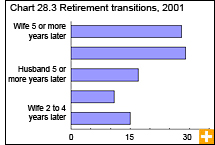Common menu bar links
Retiring together, or not
Archived Content
Information identified as archived is provided for reference, research or recordkeeping purposes. It is not subject to the Government of Canada Web Standards and has not been altered or updated since it was archived. Please contact us to request a format other than those available.
Throughout much of the last century, older couples faced only one retirement decision—the husband’s. However, the rise and sustained participation of women in the paid labour force since the 1970s transformed the retirement transitions of married couples. Increasingly, couples have to make two decisions and balance the preferences and constraints of partners who both made substantial contributions to household income.
Evidence indicates that, instead of retiring together, through the 1990s such dual-income couples were increasingly retiring at different times.
The opportunity to retire jointly may be constrained by factors such as age differences, health conditions, eligibility for pensions, job loss and career aspirations.
The likelihood that spouses will retire jointly is greater among older couples than younger couples. The age difference between spouses was also a factor. A wife who is much younger than her husband is more likely to continue working after he retires than a wife who is about the same age as or older than her husband


